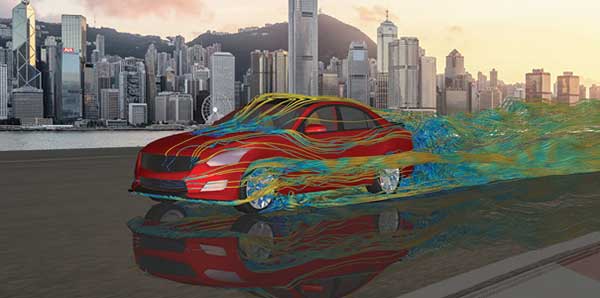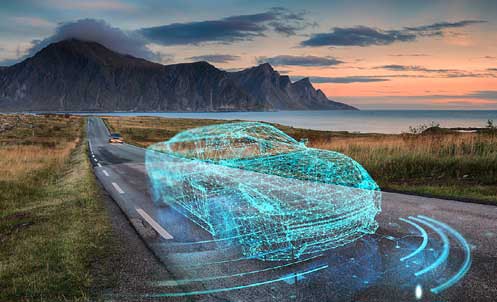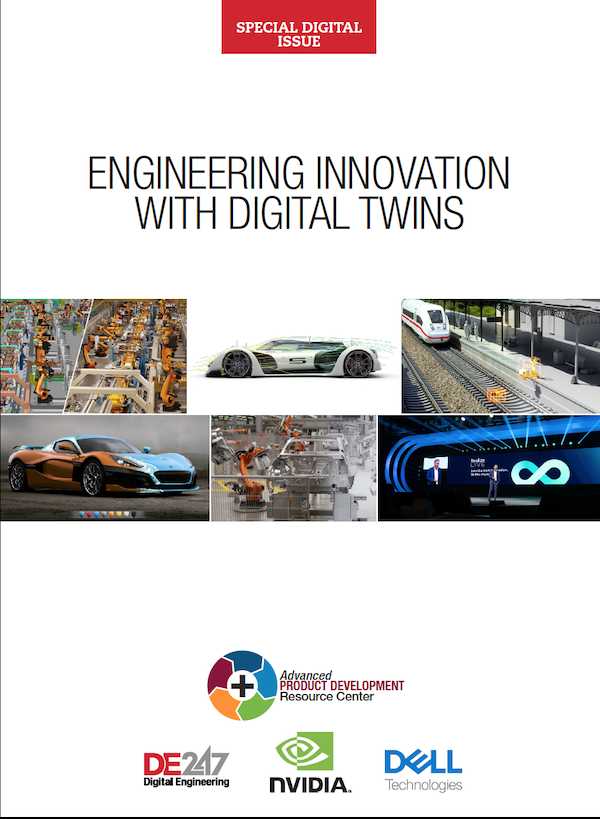Holistic Digital Twin: the Backbone of Product Development
The comprehensive digital twin, built around state-of-the-art simulation and testing tools, is key to helping automotive OEMs remain competitive and embrace complexity.

Advanced visualization of external flow in Simcenter STAR-CCM+ helps deliver insights to improve aerodynamic performance. Images courtesy of Siemens Digital Industries Software.
Latest News
September 15, 2020
By Nand Kochhar
The boundaries between automotive design and vehicle product life after delivery are disappearing. This trend will transform automotive development from a process that delivers discrete generations into a continuous process that tracks individual vehicles and constantly updates them until end of life. The comprehensive digital twin, built around leading-edge simulation and testing tools, is key to achieving this new reality to help automotive original equipment manufacturers (OEMs) remain competitive and embrace complexity.
Within the last few years, a convergence of technologies has transformed the automotive industry. Consider the emergence of viable electric vehicles and the potential of new materials to change the relation between form and function to provide vehicle lightweighting, helping to extend the range of the electric vehicle. Trends for mass personalization and new manufacturing processes such as additive or 3D printing make it possible to produce shapes that were never before possible. And the integration of software and electronics are improving performance, while paving the way to the ultimate goal of fully autonomous driving.
However, the result of all this is an increase in the complexity of products and processes used to engineer and manufacture vehicles. How does a company that is expert in internal combustion engines lead the way in battery technology or autonomous sensing technology?

Success in this demanding new environment requires fusing various domains of engineering to design and manufacture the product, thereby accelerating digital transformation—becoming digital enterprises that share data and collaborate in the design, manufacture and deployment of products and processes. All this requires embracing the concept of a comprehensive digital twin.
Benefits of Digital Twin Approach
The digital twin is a way to address challenges of complex vehicle system development by building a set of highly accurate models that help predict product behavior during all lifecycle phases of the vehicle. These models come in multiple scales and instances for various applications, integrate multiple physical aspects, contain the best available physical descriptions and mirror the life of the product and its production process.
When companies integrate all these models, they have access to a holistic digital twin that becomes the backbone of their product development—capable of delivering greater insight, reducing development cycle time, improving efficiency and increasing market agility.
If the comprehensive digital twin is critical to the future of automotive engineering innovation, simulation and test are the beating heart of the digital twin, providing insight into the real-world performance of the vehicle and accelerating innovation over the entire lifecycle. Simulation and test can predict every aspect of product performance, which enables the digital twin to evolve throughout every challenge a product faces in its operational lifetime.
By providing an integrated view on the vehicle’s physical and behavioral aspects, the digital twin allows simultaneous balancing of all functional performance requirements throughout the development cycle.
The comprehensive digital twin helps to break down silos and blur boundaries between engineering disciplines, teams and organizations so companies achieve engineering effectiveness, scaling from components to full system and model-based systems engineering.
Investing in the Digital Twin
It is imperative for OEMs and their tier 1 and tier 2 suppliers to start their journey toward the implementation of a digital twin strategy now rather than wait for some future event to trigger investment, by which time it may be too late.
To help companies take a measured approach to adopting a digital twin in product development, companies should aim to focus on realism, continuity and exploration.
Realism: To address increasingly complex systems and technologies, it is critical that companies have a realistic representation of their product to instill confidence in their designs and ensure that design decisions are correct. More sophisticated simulation models yield results that are closer to reality by combining disciplines and physics, including, for example, a computational fluid dynamics (CFD) model of the vehicle, a structural dynamics model, a thermodynamics model, a stress analysis model and a fatigue-cracking model.
Improved confidence in simulation and test data can reduce the need for over-design, end-of-cycle physical testing and numerous field failures. All this leads to faster time to market and significant cost savings.
Continuity: To support the comprehensive digital twin, it is critical that performance engineering processes are not isolated and disconnected from the rest of the organization or the product lifecycle management (PLM) process. If companies can reduce barriers and enable collaboration across their suppliers, they not only increase their process efficiency, but they also get a more holistic view. This enables them to make the right decisions with all stakeholders in the supply chain across the organization and close the loop between requirements, design and verification over the complete engineering cycle.
Exploration: Realistic and integrated processes and models need to be deployed to yield the necessary insight for making rapid design decisions. For the most benefit from simulation tools, engineers need to intelligently explore the design space, as well as quickly understand design drivers and trade-offs to discover better designs. The comprehensive digital twin enables the frontloading of multidiscipline and multiphysics simulation earlier in the design process, giving engineers the freedom to rapidly evaluate possible alternatives and quickly innovate to find the best design.
Digital Twin Influence on Decision-Making
A digital twin can also deliver insights to influence decisions about service or predictive maintenance, timing of upgrades to improve performance or decisions made during development phases. Sensors on the vehicle can easily give feedback to the development team, enabling engineers to enhance their simulation to make better predictions and plan updates or maintenance. They can decide to replace parts or components. Or they can use all this information as improved starting parameters or boundary conditions when working on the next generation design.
Comprehensive Journey
When automotive companies transform their performance engineering processes based on a digital twin approach, they are able to engineer innovation. The digital twin helps accelerate complex system development by leveraging robust simulation and test capabilities for enhanced vehicle performance engineering. Once the vehicle is out in the real world, the digital twin then can be used to understand and predict performance and behavior. Ultimately automotive companies are able to bring better, more innovative products to market faster at a lower cost to keep pace with emerging capabilities such as electric and autonomous vehicles—helping transform complexity into a competitive advantage.
Nand Kochhar is vice president of Automotive and Transportation Industry Strategy, Siemens Digital Industries Software.






